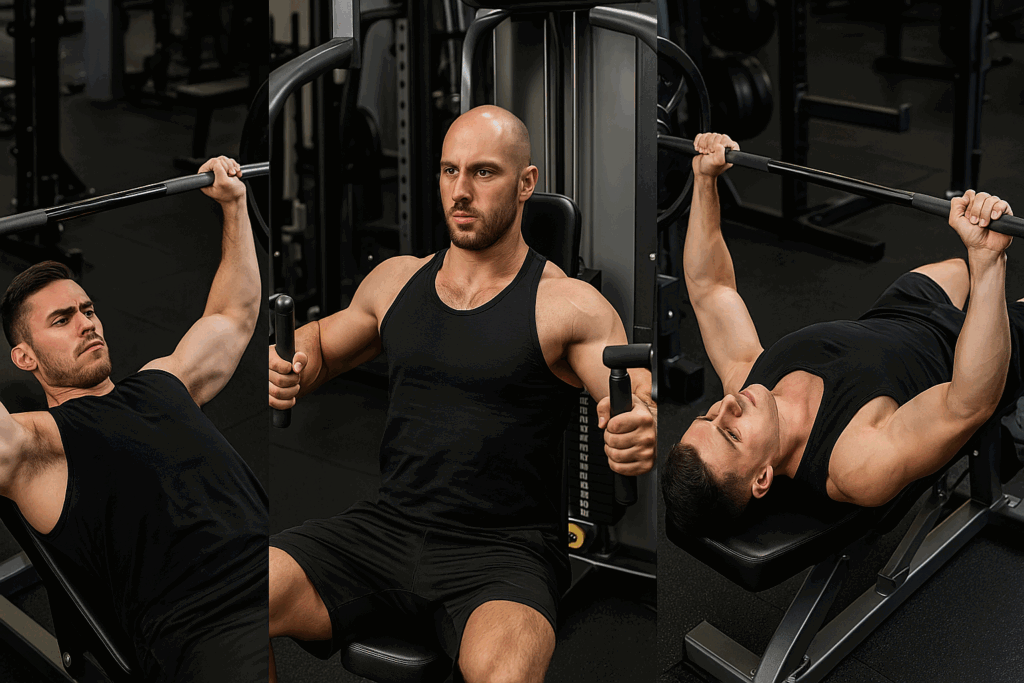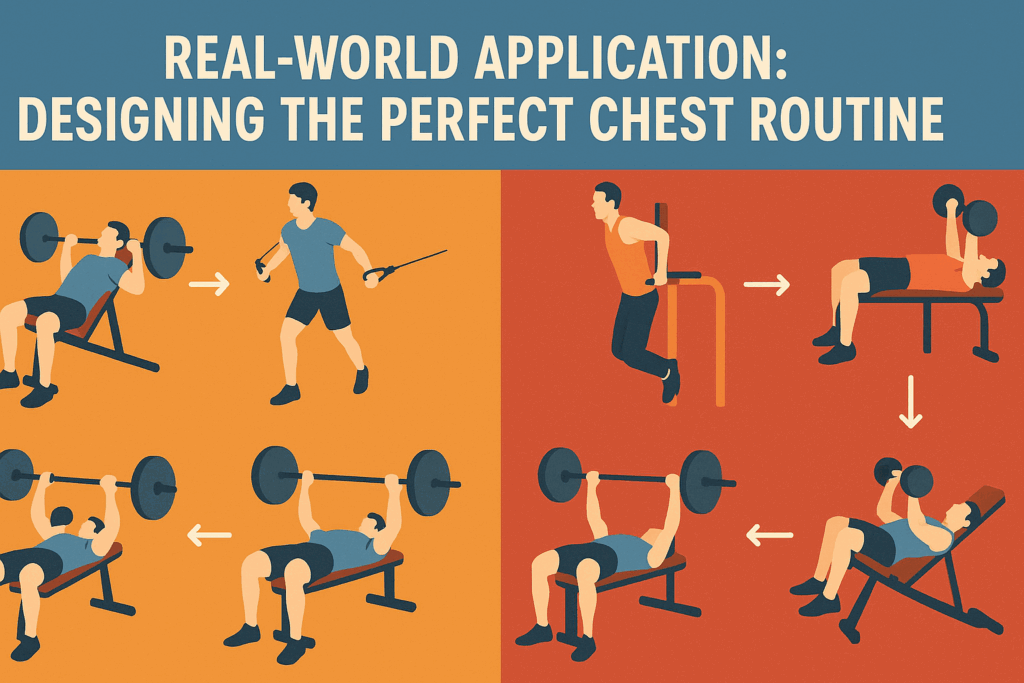Introduction: Rethinking Chest Day for Maximum Efficiency and Gains
Building a strong, muscular chest is a cornerstone goal for many fitness enthusiasts, from casual gym-goers to competitive bodybuilders. However, the question of how many chest exercises per workout one should perform remains a topic of heated debate in both online forums and scientific circles. Some advocate for minimalist routines with just one or two key lifts, while others promote exhaustive, multi-angle attack plans involving five or more exercises per session. The truth, as with most things in strength training, lies somewhere in between—and depends on several critical factors including your training goals, experience level, recovery ability, and overall program design.
Determining the optimal number of chest exercises per session is not a one-size-fits-all equation. It involves a nuanced understanding of muscle physiology, hypertrophy principles, training volume, and exercise selection. Equally important is understanding how many sets for hypertrophy are appropriate for stimulating muscle growth without tipping into overtraining. A well-balanced chest training plan takes all of these variables into account and is built upon a scientific foundation that ensures both safety and long-term progress.
In this comprehensive guide, we will explore the science and strategy behind effective chest workouts. We’ll analyze how many sets per muscle group per week are ideal for hypertrophy, explain how exercise variation affects muscular adaptation, and provide real-world recommendations that align with cutting-edge research. Whether you’re training for size, strength, or aesthetic symmetry, this guide will equip you with the expert-level knowledge you need to structure your chest workouts for optimal results.
You may also like: The Ultimate Hypertrophy Workout Program for Building Strength and Size

Understanding Chest Anatomy and Muscle Activation
Before diving into the specifics of programming, it’s essential to understand the anatomy of the chest and how different exercises activate its various components. The chest is primarily composed of two muscles: the pectoralis major and the pectoralis minor. The pectoralis major is the larger of the two and can be subdivided into the clavicular (upper), sternal (middle), and costal (lower) regions. Each region plays a slightly different role in shoulder flexion, horizontal adduction, and internal rotation.
The pectoralis minor lies beneath the major and plays a stabilizing role, especially during movements involving scapular depression and downward rotation. Together, these muscles work in concert with the deltoids, triceps, and serratus anterior during most chest movements. However, the degree to which each area of the pectoralis major is activated depends largely on the angle of movement. For instance, incline presses target the upper chest more effectively, while flat and decline presses emphasize the mid and lower fibers, respectively.
When designing a chest workout, it’s crucial to consider this regional activation. Relying solely on flat bench press variations can result in uneven development over time. This is one of the key reasons why understanding how many chest exercises per workout you actually need is so important—it’s not just about quantity but also about variety and intention. Strategic variation ensures all regions of the chest are adequately stimulated and helps avoid plateaus in growth.

The Science Behind Muscle Hypertrophy and Training Volume
Hypertrophy, or the enlargement of muscle fibers, is the primary goal for those seeking aesthetic and strength-based improvements. Research in exercise science consistently points to training volume—defined as the total number of sets, reps, and load per muscle group—as a key driver of hypertrophy. However, more volume doesn’t always mean more gains. There is a threshold beyond which additional sets provide diminishing returns and may even impair recovery.
When it comes to determining how many sets per week for hypertrophy, current evidence suggests that 10 to 20 sets per muscle group per week is an effective range for most intermediate lifters. For chest development specifically, this means performing 3 to 5 chest exercises per week, each comprising 3 to 4 sets. The total should add up to approximately 15 sets of chest per week, distributed over one to three training sessions depending on your split.
Moreover, it’s critical to consider that not all sets are created equal. Sets taken close to muscular failure—especially within the 6–12 rep range—are significantly more effective for hypertrophy than those performed with lighter loads or without sufficient intensity. This underscores the importance of quality over sheer quantity. If you’re asking how many sets of chest per week are optimal, the answer lies not just in the number but in the execution of each set.

How Many Chest Exercises Per Workout: What the Research Shows
A common mistake among lifters is equating longer workouts with superior results. Some chest routines feature six or more exercises in a single session, resulting in excessive volume that the body struggles to recover from. While variety has its place, overcomplicating a workout can lead to diminishing returns, fatigue, and joint stress. So, how many chest exercises per workout do you really need?
Studies show that selecting two to four chest exercises per session is sufficient to target the muscle effectively while allowing room for recovery and progressive overload. This range provides the necessary mechanical tension, metabolic stress, and muscle damage to stimulate growth without causing burnout. For instance, combining a compound pressing movement with an isolation exercise—such as a flat barbell bench press followed by cable flyes—can yield excellent hypertrophic results.
The key is to select exercises that emphasize different portions of the chest and utilize varying movement patterns. A well-structured workout might include an incline dumbbell press for upper pecs, a flat bench press for mid-pecs, and a dip or cable crossover for the lower pecs. This balanced approach ensures that each region of the chest is engaged without redundancy. By staying within this range and prioritizing intensity and form, you’ll be maximizing your return on investment in the gym.
Optimizing Training Frequency and Sets Per Muscle Group for Hypertrophy
Training frequency—the number of times you train a specific muscle group per week—has a profound impact on muscle growth. While traditional “bro splits” that hit each muscle once per week are still popular, research increasingly supports higher frequency training for hypertrophy. Hitting the chest twice per week allows for better volume distribution, improved muscle protein synthesis, and more frequent stimulus without exceeding recovery capacity.
When spread across two sessions, performing 3 to 4 exercises per workout becomes manageable and effective. This equates to approximately 6 to 8 total chest exercises weekly, broken down into 3 to 4 sets each. That brings your weekly volume to 12 to 20 sets—an ideal range supported by literature on sets per muscle group per week for hypertrophy. Additionally, this structure allows for strategic exercise variation, targeting different angles and fibers over multiple sessions.
Another advantage of splitting chest volume across multiple days is the opportunity to train with higher quality. Fatigue from high-volume single-session workouts can reduce output and form quality on later exercises. By distributing the load, each set and rep receives greater attention, resulting in more effective hypertrophic stimulus. If your goal is maximum growth, consider how your training split affects how many sets for hypertrophy you can effectively execute.

The Role of Exercise Selection and Variation in Chest Growth
Exercise selection is a critical component of muscle development. Choosing the right movements for your body type, experience level, and goals can mean the difference between steady progress and persistent frustration. When considering how many chest exercises per workout to include, it’s essential to evaluate not only the quantity but also the quality of those choices.
Free weight movements such as barbell and dumbbell presses remain the foundation of most effective chest routines. They allow for heavy loading and multi-joint recruitment, making them ideal for developing overall mass and strength. However, machines and cables offer unique advantages, including improved isolation, consistent tension throughout the range of motion, and reduced stabilization demands—beneficial during fatigue or for targeting specific muscle regions.
Rotating your exercise selection every 4 to 6 weeks can help mitigate adaptive resistance and encourage continuous growth. This doesn’t require a complete overhaul of your routine but rather strategic substitutions. For example, swapping a barbell bench press with a dumbbell press or replacing cable crossovers with pec deck flyes can refresh your neural engagement and promote new hypertrophic adaptations. The variety also supports joint health by altering movement patterns and load distribution.
Understanding the biomechanics of each exercise can enhance your program design. Incline presses increase activation of the upper pecs, while decline presses shift emphasis to the lower fibers. Fly variations—whether with cables or dumbbells—create peak tension at the end of the range, where pressing exercises often fall short. By incorporating a thoughtful mix of movements, you ensure comprehensive chest development with fewer exercises per session.
Balancing Volume, Intensity, and Recovery for Sustainable Progress
When designing a training program aimed at maximizing chest hypertrophy, it’s essential to understand the intricate interplay between volume, intensity, and recovery. Many lifters find themselves in a cycle of high-intensity chest workouts followed by insufficient rest, which can lead to stagnation or even regression over time. The principle of progressive overload relies on the body’s ability to adapt to increasing demands—but without adequate recovery, this adaptation cannot occur efficiently. Thus, understanding how many sets per week for hypertrophy your body can handle without entering a state of overtraining is paramount.
If you’re pushing hard on every set and pushing close to failure, your capacity for high volume diminishes. In this case, fewer total sets—within the range of 10 to 14 sets of chest per week—may be more appropriate, particularly when exercises are executed with maximal focus and control. On the other hand, if you’re training with moderate intensity, a slightly higher weekly volume (closer to 16 to 20 sets per muscle group per week) might be required to elicit the same degree of muscular tension and metabolic stress. In either case, quality and recovery must take precedence over chasing arbitrary numbers.
Another variable worth considering is the type of split you follow. If you’re performing full-body workouts three times per week, each session might include one or two chest exercises, for a total of 3 to 6 weekly chest movements. In contrast, a push-pull-legs split might allow for more focused chest sessions with three or four exercises at a time. Regardless of the split, the total weekly sets per muscle group for hypertrophy should be your guiding metric, adjusted for intensity and recovery capabilities.
Sleep, nutrition, and periodization also play vital roles in recovery and long-term progress. A nutrient-dense diet rich in lean proteins, complex carbohydrates, and healthy fats provides the substrate needed for muscle repair and growth. Sleep supports hormonal regulation and neuromuscular recovery. Periodizing your training—alternating between phases of high volume and phases of reduced intensity or deload weeks—can also prevent stagnation and optimize long-term gains. These recovery strategies ensure that your training—no matter how many chest exercises per workout you include—remains sustainable and effective over time.

How Many Chest Exercises Per Workout for Beginners vs. Advanced Lifters
The ideal number of chest exercises per session often depends on an individual’s training experience. Beginners, who are still building neuromuscular coordination and base strength, require far less variety and volume to stimulate hypertrophy. In fact, novice lifters can make impressive gains with just one or two compound chest exercises per session performed with moderate volume and excellent technique. A flat bench press combined with an incline dumbbell press, for example, may provide sufficient stimulation for both upper and mid-pec fibers while building a solid strength foundation.
At this stage, consistency and progressive overload take precedence over complex programming. Beginners are highly responsive to training stimuli, and their nervous systems are still adapting to the motor patterns associated with pressing and fly movements. Overcomplicating their routine with excessive variation can dilute effort and lead to form breakdown. Instead, focusing on movement mastery, controlled tempo, and steady weight progression yields better and safer results.
Intermediate and advanced lifters, on the other hand, often require greater exercise variation and volume to continue progressing. Their muscles have adapted to basic stimuli and now need more targeted approaches to stimulate growth. For these individuals, three to four exercises per chest workout can provide a well-rounded stimulus, especially when training specific regions of the chest. A sample routine might include incline presses, flat presses, dips, and isolation fly variations to comprehensively challenge all fibers of the pectoralis major.
Advanced lifters also benefit from nuanced strategies like rest-pause sets, drop sets, and tempo manipulation. These methods can enhance muscle activation and metabolic stress without necessarily increasing the number of exercises performed. This highlights the importance of efficiency—maximizing output and tension within a reasonable volume framework. Ultimately, whether you’re a novice or a seasoned athlete, the goal is to select the optimal number of exercises that stimulate growth without compromising recovery or exercise quality.

Real-World Application: Designing the Perfect Chest Routine
To put theory into practice, let’s examine what a well-designed chest workout might look like depending on your training split. Assume you’re following a push-pull-legs split and training chest twice per week. Your first session might focus on upper and mid-pecs using compound lifts, while the second emphasizes mid to lower chest with a mix of compound and isolation exercises. In each workout, selecting three chest exercises with 3 to 4 sets each ensures you remain within the 12 to 20 sets of chest per week guideline for hypertrophy.
A sample Monday session might include an incline barbell bench press, a flat dumbbell press, and incline cable flyes. These exercises target the upper and mid-portion of the chest, offering a balance of load-based tension and peak contraction. By Friday, you could shift to dips, flat bench press, and decline cable flyes—exercises that emphasize the lower chest and complete the development of the pectoralis major. This structure not only answers how many chest exercises per workout are necessary but also ensures strategic fiber recruitment across the week.
Another consideration is integrating chest training with synergistic muscle groups. The triceps and anterior deltoids are heavily involved in pressing movements, so overtraining these areas can compromise chest performance. If your triceps are fatigued from prior sessions, they may limit your ability to push maximal loads during chest exercises. This is why full-body programming and weekly scheduling are crucial when determining how many sets per muscle group per week your body can truly tolerate without overlap-induced fatigue.
Rest intervals, rep ranges, and training tempo further refine the routine. For hypertrophy, aim for 60 to 90 seconds of rest between sets to maximize metabolic stress while maintaining performance. Stick to rep ranges between 6 and 12 for most compound lifts and 10 to 15 for isolation work. Use a controlled tempo to maintain time under tension—this simple strategy often yields better results than increasing volume indiscriminately. When implemented thoughtfully, these elements harmonize to create a balanced and effective chest training program.
Common Pitfalls and Myths About Chest Training Volume
Despite the abundance of information available today, myths surrounding chest training continue to persist. One such myth is that more exercises and more sets always translate to more growth. This mentality often leads to marathon workouts involving six or more exercises and upwards of 30 sets in a single session—an approach that may be counterproductive. Overtraining can impair recovery, reduce performance in subsequent sessions, and even increase the risk of joint and tendon injuries.
Another common misconception is that the bench press is the only movement needed for a complete chest. While the bench press is a valuable exercise, relying on it exclusively can result in underdeveloped upper and lower pecs. To achieve full, symmetrical development, it’s necessary to include incline, decline, and fly movements in your routine. This ensures that all muscle fibers are recruited and helps prevent aesthetic imbalances that become more pronounced over time.
It’s also important to dispel the belief that soreness is an accurate indicator of an effective workout. While delayed onset muscle soreness (DOMS) can occur after particularly intense sessions, it is not a reliable gauge of growth. What matters more is consistent progression in volume, load, and technique. Tracking your total sets per week for hypertrophy and monitoring performance trends over time provides far more actionable feedback than simply chasing muscle soreness.
Lastly, some lifters fall into the trap of program-hopping—constantly changing exercises and volume before their bodies have time to adapt and grow. While variation is important, it should be introduced methodically, not randomly. Sticking to a well-designed routine for 6 to 8 weeks allows for progressive overload and meaningful adaptation. Then, minor adjustments—such as swapping one pressing variation for another—can keep your training fresh without derailing your overall structure.
How Many Chest Exercises Per Workout: Final Thoughts and Practical Takeaways
Bringing together the principles explored throughout this guide, it becomes clear that answering how many chest exercises per workout you should perform depends on your goals, experience level, and training frequency. For most lifters, two to four exercises per session provide the ideal blend of intensity, variety, and volume necessary for maximum chest development. This approach aligns with current hypertrophy research and ensures that each region of the chest receives adequate stimulation without overreaching.
It’s equally essential to understand how many sets of chest per week and how many sets per muscle group for hypertrophy are appropriate. Most evidence supports performing 10 to 20 high-quality sets per muscle group per week, distributed over two or more sessions. If your program is designed with this total in mind, you can confidently plan each chest workout to include the right number of exercises and sets while leaving room for progressive overload, strategic variation, and recovery.
Ultimately, thoughtful programming—rooted in scientific evidence and personalized to your needs—is the key to unlocking lasting gains. Avoid the extremes of undertraining or overtraining, and instead embrace a balanced, sustainable approach that prioritizes form, effort, and consistency. This method not only builds a strong, well-defined chest but also fosters long-term adherence and injury-free training.
Frequently Asked Questions: How to Master Chest Volume for Maximum Growth
How many chest exercises per workout should I do if I’m training for strength instead of hypertrophy?
If your primary goal is strength rather than hypertrophy, the number of chest exercises per workout will differ slightly. Strength-focused programs emphasize neurological efficiency and compound movement mastery, so fewer exercises with heavier loads and lower reps are generally more effective. Typically, two to three exercises per session are sufficient, with a strong focus on the bench press and its variations. You might perform flat bench press for low reps and high load, followed by incline dumbbell press or weighted dips to maintain overall chest development. Since the focus is on intensity, you’ll likely perform fewer total sets per week for hypertrophy but with significantly higher loads and longer rest intervals to accommodate nervous system recovery.
Can changing the order of exercises impact how many sets for hypertrophy are effective?
Yes, exercise order can significantly influence the effectiveness of your sets for hypertrophy. Starting with a challenging compound lift like the bench press can pre-fatigue the chest, reducing the load you can lift on subsequent exercises but increasing overall metabolic stress. Conversely, placing an isolation exercise like a cable fly first can improve muscle activation and provide a more targeted stimulus, especially for lifters with trouble feeling the chest during presses. By altering the order periodically, you can introduce new stressors to the muscle, which may allow you to benefit from the same total volume without necessarily increasing the number of sets per muscle group for hypertrophy. This variation can keep workouts stimulating while optimizing both fatigue management and mind-muscle connection.
What role does tempo play in determining how many sets of chest per week I should perform?
Tempo manipulation can significantly impact training stimulus, and therefore may reduce the number of sets of chest per week needed for results. Slowing down the eccentric (lowering) portion of each rep increases time under tension, which enhances muscle fiber recruitment and microtrauma—key elements in hypertrophy. A slower tempo also demands more control, which can improve joint health and exercise quality. By increasing rep quality through tempo changes, you may not need to increase how many sets per week for hypertrophy you complete, because each set becomes more efficient and taxing. This strategy is especially useful for advanced lifters looking to intensify training without excessively increasing weekly volume.
How do exercise machines affect how many chest exercises per workout are necessary?
Incorporating machines like the pec deck or Hammer Strength press can change how many chest exercises per workout you need. Machines provide consistent resistance across the entire range of motion and minimize the need for stabilizer muscles, which can help isolate the chest more effectively and extend time under tension. As a result, you may find that two well-executed machine-based exercises offer the same hypertrophic stimulus as three or more free-weight variations. For those with joint limitations or during high-volume phases, machines offer a valuable alternative that allows for more targeted volume without overloading connective tissues. This efficiency can reduce the overall exercise count per session while still fulfilling your sets per week for hypertrophy target.
Is there a benefit to increasing how many sets per muscle group per week gradually over time?
Yes, gradually increasing how many sets per muscle group per week is a proven method for progressive overload. This technique, known as volume ramping, involves starting a training block with lower volume—perhaps 10 to 12 sets of chest per week—and incrementally adding sets each week over 4 to 6 weeks. This progressive increase challenges the muscle with greater workload while allowing your recovery systems to adapt gradually. Once you reach the upper threshold, such as 18 to 20 sets, you can perform a deload or reduce volume temporarily to prevent overtraining. This cyclical approach to volume helps avoid stagnation and reduces injury risk while still supporting hypertrophic adaptation.
How many sets for hypertrophy should I do if I’m in a caloric deficit?
Training in a caloric deficit requires strategic adjustments to volume and intensity. Since your body has fewer resources for recovery, performing too many sets per muscle group for hypertrophy can quickly lead to overtraining. Reducing overall volume to around 60–75% of what you’d do in a surplus is often advisable—so instead of 18 sets of chest per week, you might aim for 10 to 12 sets, focusing on higher intensity and perfect form. It’s also beneficial to prioritize compound movements that yield the most return on effort, while minimizing isolation exercises that add fatigue without contributing significantly to muscle preservation. The goal during a deficit should be to maintain lean mass with fewer, high-quality sets.
What are some signs that I’m doing too many chest exercises per workout?
If you’re experiencing persistent soreness, declining performance, or joint discomfort, you may be doing too many chest exercises per workout. Overtraining symptoms often show up as stalled progress, irritability, and reduced motivation to train. Another red flag is poor recovery—if your chest still feels inflamed or tight days after training, your session volume may be too high. Chronically exceeding the recommended sets per week for hypertrophy without proper rest can also impair central nervous system function and reduce strength output. To avoid this, periodically audit your program to ensure you’re within the 10 to 20 set range per week and that your per-session volume remains sustainable, especially if you train chest more than once weekly.
Advanced Techniques: Can rest-pause or drop sets reduce how many sets of chest per week are needed?
Absolutely. Advanced intensity techniques like rest-pause and drop sets can allow you to achieve hypertrophy with fewer total weekly sets. These methods increase the density and fatigue of a workout, enabling you to reach a higher level of muscle fiber recruitment in a shorter time. For example, performing three rest-pause sets on an incline dumbbell press might create a similar growth stimulus as five traditional straight sets. When programmed strategically, these methods can reduce how many sets per week for hypertrophy you need, particularly if you’re short on time or training with limited equipment. However, these techniques are best reserved for experienced lifters who can manage fatigue and maintain form under stress.
How many sets per muscle group for hypertrophy should be direct chest work versus compound overlap?
Direct chest work includes movements where the chest is the primary mover, such as presses and flyes. However, many compound movements—like overhead presses or even some rowing variations—also involve the chest as a secondary stabilizer. While only direct sets count fully toward how many sets per muscle group per week are needed for hypertrophy, compound overlap still contributes marginally to overall workload. A good rule is to count full chest-focused sets completely, and count indirect contributions—like dips or pushups—at half volume. This nuance allows for better planning, ensuring you don’t overestimate how many sets of chest per week you need while still accounting for total systemic fatigue.
Are there psychological benefits to limiting how many chest exercises per workout I include?
Interestingly, yes. Limiting how many chest exercises per workout you perform can improve focus, reduce mental fatigue, and enhance long-term adherence to your program. When workouts are excessively long or packed with redundant movements, lifters often experience decision fatigue or a drop in motivation. A shorter, well-structured workout encourages more effort per set and allows for better concentration on execution and progression. Furthermore, confidence grows when lifters see measurable improvement in a few key lifts rather than spreading themselves too thin across many movements. Streamlining your sessions can lead to a stronger mind-muscle connection and a more satisfying training experience overall, especially when balanced with optimal sets per week for hypertrophy.
Conclusion: Building a Strong Chest with Smart Programming and Sustainable Volume
Crafting an effective chest routine isn’t about finding a magical number of exercises or sets—it’s about understanding the physiological and strategic principles that govern muscle growth. The best answer to how many chest exercises per workout you need comes not from mimicking someone else’s program but from tailoring your approach based on training volume, recovery, and long-term progression. Whether your focus is on maximizing mass, refining shape, or increasing strength, aligning your exercise selection with the science of hypertrophy will yield superior results.
Paying attention to how many sets per muscle group per week your body can handle, balancing intensity and recovery, and selecting movements that match your anatomical needs are all vital components of a successful chest program. Don’t fall into the trap of overtraining with excessive sets or chasing soreness as a sign of effectiveness. Instead, monitor progress objectively, listen to your body, and evolve your routine with purpose and precision.
In the end, chest training—like all resistance training—is both a science and an art. It rewards those who are methodical, patient, and disciplined. With the insights provided in this guide, you now have a powerful framework to structure your chest workouts with clarity and confidence. Whether you’re just starting out or refining a decade-long practice, this evidence-based approach will help you achieve maximum gains, one smartly programmed workout at a time.
Further Reading:
How many sets per muscle group per week do you really need to build muscle?
A Systematic Review of The Effects of Different Resistance Training Volumes on Muscle Hypertrophy
New Research Reveals the Minimum Amount of Sets per Week for Muscle Growth and for Strength





